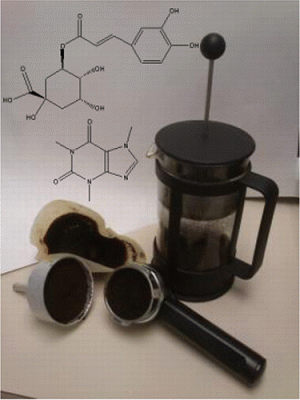To plant food, insect repellant and other homespun uses for spent coffee grounds, scientists are adding an application that could make the gunk left over from brewing coffee a valuable resource for production of dietary supplements. Their new report in ACS' Journal of Agricultural and Food Chemistry concludes that used coffee grounds are a rich source of healthful antioxidant substances.
Maria-Paz de Peña and colleagues explain that people around the world drink millions of cups of coffee every day, generating about 20 million tons of used grounds annually. Although some spent coffee grounds find commercial use as farm fertilizer, most end up in trash destined for landfills. Coffee itself is a rich source of healthful antioxidants. De Peña's team wondered about the amount of antioxidants that remained in used coffee grounds from different coffee-making methods.
They found that filter, plunger and espresso-type coffeemakers left more antioxidants in coffee grounds, while mocha coffeemakers left the least. Because filter and espresso coffeemakers are more common in homes and commercial kitchens, the authors report that most grounds are likely to be good sources of antioxidants and other useful substances. They note that after these compounds are extracted, the grounds can still be used for fertilizer.
More information: "Evaluation of Spent Coffee Obtained from the Most Common Coffeemakers as a Source of Hydrophilic Bioactive Compounds" J. Agric. Food Chem., 2012, 60 (51), pp 12565–12573. DOI: 10.1021/jf3040594
Abstract
The main hydrophilic antioxidant compounds (3-, 4-, and 5-monocaffeoylquinic and 3,4-, 3,5-, and 4,5-dicaffeoylquinic acids, caffeine, and browned compounds, including melanoidins) and the antioxidant capacity (Folin–Ciocalteu, ABTS, DPPH, Fremy's salt, and TEMPO) were evaluated in Arabica and Robusta spent coffee obtained from the preparation of coffee brews with the most common coffeemakers (filter, espresso, plunger, and mocha). All spent coffee grounds, with the exception of those from the mocha coffeemaker, had relevant amounts of total caffeoylquinic acids (6.22–13.24 mg/g of spent coffee), mainly dicaffeoylquinic acids (3.31–5.79 mg/g of spent coffee), which were 4–7-fold higher than in their respective coffee brews. Caffeine ranged from 3.59 to 8.09 mg/g of spent coffee. The antioxidant capacities of the aqueous spent coffee extracts were 46.0–102.3% (filter), 59.2–85.6% (espresso), and <42% (plunger) in comparison to their respective coffee brews. This study obtained spent coffee extracts with antioxidant properties that can be used as a good source of hydrophilic bioactive compounds.
Journal information: Journal of Agricultural and Food Chemistry
Provided by American Chemical Society





















